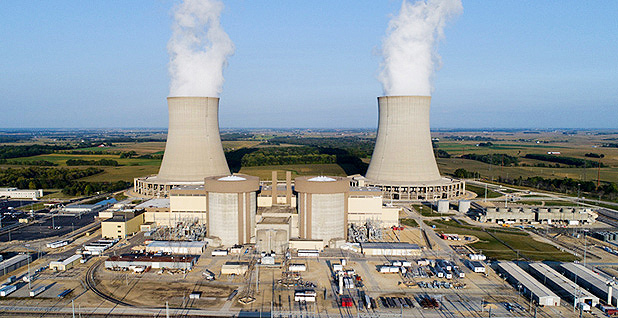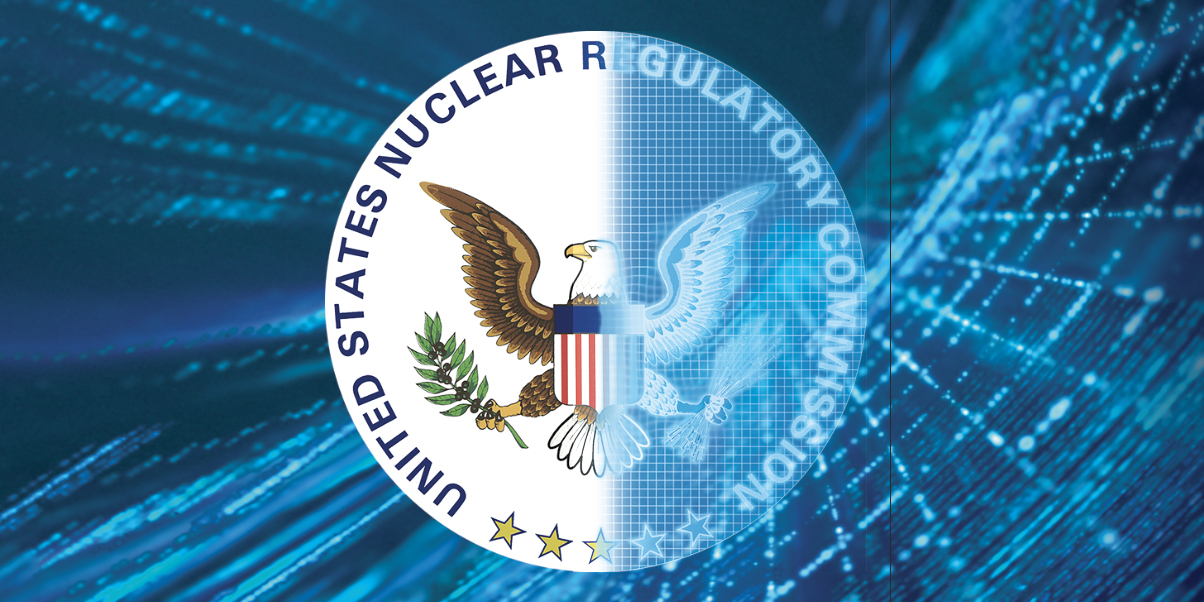Click to open full graphic
The Nuclear Regulatory Commission has issued a license to Interim Storage Partners (ISP), a joint venture of Waste Control Specialists and Orano USA, to construct and operate a consolidated interim storage facility for spent nuclear fuel in Andrews, Texas. Issued on September 13, the license comes just four days after Texas governor Greg Abbott signed a bill to block such a facility from being built in the state.
Governor J. B. Pritzker says he will sign the landmark legislation
The Byron (left) and Dresden generating stations.
The yearlong, nail-biting drama over the fate of Exelon’s Byron and Dresden nuclear plants came to an end on Monday afternoon when the Illinois Senate gave its nod to S.B. 2408, a wide-ranging clean energy package that seeks to phase out fossil-fuel power generation in the state and place it on a path to 100 percent carbon-free energy by 2050.
F Area operator Thomas Harman (left) and SRNS scientist Kevin Boerstler check the pumps, sensors, and piping that blend a base concentrate to inject into acidic groundwater at the Savannah River Site. (Photo: DOE)
The Savannah River Site is reducing the flow of hazardous and radioactive metal contaminants to South Carolina’s rivers and streams by injecting a mix of clean water and baking soda into the site’s groundwater. The base mix neutralizes groundwater that has become acidic as a result of SRS’s chemical separations work, helping restrict the flow of contaminants.
The La Crosse site in 2019 with major decommissioning completed. The coal-fired Genoa plant is in the background. (Photo: EnergySolutions)
The Nuclear Regulatory Commission has extended its orders transferring the licenses for the La Crosse and Zion nuclear power plants from EnergySolutions back to the plant owners until late 2022. This is the third time the NRC has extended the effectiveness of the license transfer orders for the decommissioned plants since approving them in 2019.
This large-bore, full-scale high-temperature superconducting magnet designed and built by Commonwealth Fusion Systems and MIT’s Plasma Science and Fusion Center is the strongest fusion magnet in the world. (Photo: Gretchen Ertl, CFS/MIT-PSFC)
A high-temperature superconducting magnet reached and maintained a magnetic field of more than 20 tesla in steady state for about five hours on September 5 at MIT’s Plasma Science and Fusion Center. Not only is the magnet the strongest high-temperature superconducting (HTS) magnet in the world by far, it is also large enough—when assembled in a ring of 17 identical magnets and surrounding structures—to contain a plasma that MIT and Commonwealth Fusion Systems (CFS) hope will produce net energy in a compact tokamak device called SPARC in 2025, on track for commercial fusion energy in the early 2030s.
The Byron nuclear power plant
(This story has been updated from yesterday's post about the Illinois energy package.)
With only days remaining before the scheduled retirement of Exelon Generation’s Byron nuclear plant, the Illinois House has approved a comprehensive energy package (S.B. 2408) that would save the plant, as well as the state’s similarly struggling Braidwood and Dresden facilities.
A rendition of the VTR. (Graphic: DOE)
In an op-ed published online yesterday in The Hill, Ted Nordhaus and Adam Stein of the Breakthrough Institute pick apart arguments made against funding for the construction of the Versatile Test Reactor at Idaho National Laboratory. Nordhaus and Stein contend that opposition to the VTR has been led by “entrenched opponents of nuclear energy” who “fear that innovation of the sort that many U.S. nuclear startups are presently betting on might give the technology a second life.”
Energy secretary Jennifer Granholm (seated at left) and Ukrainian energy minister Herman Galushchenko (seated at right) on August 31 sign an agreement to bolster U.S.-Ukrainian energy cooperation. Ukraine’s president, Volodymyr Zelensky, stands in the background. (Photo: DOE)
U.S. energy secretary Jennifer Granholm and Ukrainian energy minister Herman Galushchenko last week signed a joint statement of intent to advance energy and climate cooperation through the U.S.-Ukraine Strategic Energy and Climate Dialogue. The signing took place during a visit to Washington, D.C., by Ukrainian president Volodymyr Zelensky for meetings with President Biden at the White House.
Operators disassemble a cutter head inside a module at the Savannah River's Tritium Extraction Facility using manipulators and hand tools. (Photo: SRNS)
Using basic hand tools and remote manipulators, operators at Savannah River Nuclear Solutions (SRNS) were able to reduce radiation exposure to workers performing cutter head maintenance in the Savannah River Site’s Tritium Extraction Facility (TEF).
According to SRNS, the innovative procedure proved to be an excellent example of real-world application of As Low As Reasonably Achievable (ALARA) principles of time, distance, and shielding.
NorthStar is challenging the sale of Kewaunee to EnergySolutions. (Photo: Dominion Generation)
NorthStar Group Services is being allowed to intervene in Wisconsin’s regulatory review of the sale of the Kewaunee nuclear power plant by Dominion Energy to EnergySolutions for decommissioning. An administrative law judge granted NorthStar permission on September 7 to participate in the Public Service Commission of Wisconsin’s review of the transaction.
During a recent road closure on the Hanford Site, Florida International University students (from left) Jeff Natividad, Joel Adams, and Thi Tran test a radiation mapping robot outside a tank farm. The students are part of a unique internship program between the DOE’s Office of Environmental Management and the university. (Photo: DOE OEM)
As part of a fellowship program between the Department of Energy’s Office of Environmental Management and Florida International University, a group of FIU students participated in a summer internship initiative called the Science and Technology Workforce Development Program. The program is run in conjunction with Washington River Protection Solutions (WRPS), the Hanford Site’s tank operations contractor in Washington state.
A statement from Steven P. Nesbit, president of the American Nuclear Society, and Lonnie R. Stephenson, international president of the International Brotherhood of Electrical Workers.
September 8, 2021, 6:59AMANS Nuclear CafeSteven P. Nesbit and Lonnie R. Stephenson America’s electric utility workers and nuclear engineers are ready to work together to help rapidly decarbonize and electrify the economy. We welcome provisions in the bipartisan infrastructure bill that aim to prevent premature closures of our nuclear power plants. Through measures such as production tax credits, President Biden can safeguard America’s largest carbon-free energy source by recognizing the clean-air contributions of nuclear energy.
During the week-long mission, the IAEA team is carrying out practical NDT training with specialized equipment. (Photo: Abel Domato/BAC)
In the aftermath of a devastating explosion in the port of Beirut, Lebanon, in August 2020, an International Atomic Energy Agency team visited the country at the government’s request and found no evidence of artificial radionuclides and no increase in radiation levels. The powerful blast, which was caused by an explosion of improperly stored ammonium nitrate, killed more than 200 people and leveled numerous buildings while leaving other buildings standing with possible structural damage. The IAEA recently announced that a different team of experts has traveled to Lebanon with a new mission: to assist the nation in the use of non-destructive testing (NDT) to check the structural soundness of buildings that were impacted by the explosion.
















 Nuclear power plants around the world generated 2,553 TWh of electricity in 2020, a drop of 104 TWh from 2019’s total, according to
Nuclear power plants around the world generated 2,553 TWh of electricity in 2020, a drop of 104 TWh from 2019’s total, according to 
